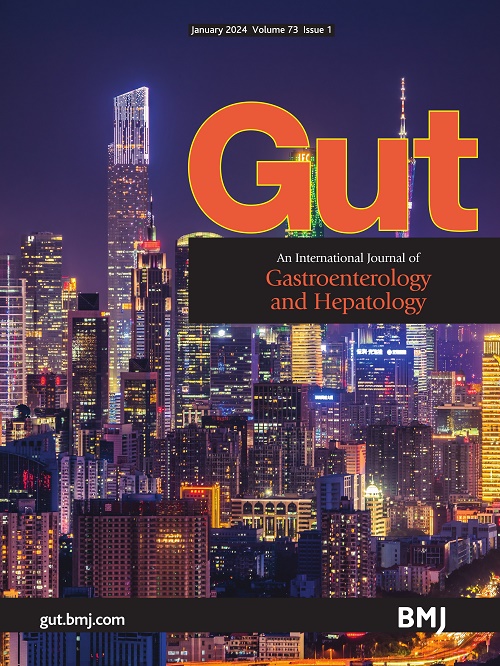Enterococcus faecalis hijacks FABP2 to activate quorum-sensing signals and aggravate Crohn’s disease by inducing gut dysbiosis
IF 23
1区 医学
Q1 GASTROENTEROLOGY & HEPATOLOGY
引用次数: 0
Abstract
Background Crohn’s disease (CD) is a chronic inflammatory disorder characterised by intestinal dysbiosis. While inflammation-induced leakage of host proteins is a known phenomenon in CD, how these proteins affect the gut microbiota and contribute to dysbiosis remains unclear. One hypothesis is that commensal bacteria hijack these proteins, exacerbating inflammation in CD. Design To investigate host-microbiota interactions in CD, we measured fatty acid-binding protein 2 (FABP2) levels in patients with CD and in mouse models of dextran sulfate sodium induced enteritis and interleukin 10 knockout spontaneous enteritis. Proteomic approaches, including bacterial pull-down and mass spectrometry, were employed to identify commensal targets of FABP2. Functional studies were conducted using wild type and EF3041 -deficient Enterococcus faecalis strains, along with α-FABP2 antibody treatment, to assess their effects on intestinal inflammation and microbiota composition. Results FABP2 levels were elevated in plasma and faeces of patients with CD, as well as in the mouse models. This was accompanied by dysbiosis of gut commensal bacteria. E. faecalis hijacked luminal FABP2 to promote its proliferation via pheromone-binding protein EF3041, which activated quorum-sensing pathways. Deletion of EF3041 abolished this response, while complementation with EF3041 restored it. Injection of α-FABP2 antibody or transplantation of Δ EF3041 mutant strain significantly reduced epithelial damage, mitigated dysbiosis and alleviated inflammation and symptoms of enteritis in mice. Conclusion This study reveals a novel mechanism by which commensal bacteria use host-derived FABP2 to drive dysbiosis and worsen CD pathology. Targeting the FABP2-EF3041 axis may offer new diagnostic and therapeutic avenues for managing CD. Data are available upon reasonable request. All data relevant to the study are included in the article or uploaded as supplementary information. Not applicable.粪肠球菌劫持FABP2激活群体感应信号,通过诱导肠道生态失调加重克罗恩病
克罗恩病(CD)是一种以肠道生态失调为特征的慢性炎症性疾病。虽然炎症诱导的宿主蛋白渗漏是已知的乳糜泻现象,但这些蛋白质如何影响肠道微生物群并导致生态失调仍不清楚。一种假设是共生菌劫持了这些蛋白质,加剧了CD中的炎症。设计为了研究CD中宿主-微生物群的相互作用,我们测量了CD患者和葡聚糖硫酸钠诱导的肠炎和白细胞介素10敲除自发性肠炎小鼠模型中脂肪酸结合蛋白2 (FABP2)的水平。蛋白质组学方法,包括细菌下拉和质谱法,被用来鉴定FABP2的共生靶点。利用野生型和缺乏EF3041的粪肠球菌菌株进行功能研究,并结合α-FABP2抗体治疗,评估其对肠道炎症和微生物群组成的影响。结果小鼠模型和CD患者血浆和粪便中FABP2水平升高。这伴随着肠道共生菌的生态失调。粪肠杆菌通过信息素结合蛋白EF3041劫持腔内FABP2促进其增殖,激活群体感应途径。删除EF3041消除了这种反应,而与EF3041互补则恢复了这种反应。注射α-FABP2抗体或移植Δ EF3041突变株可显著降低小鼠上皮损伤,减轻生态失调,减轻炎症和肠炎症状。结论本研究揭示了共生菌利用宿主源性FABP2驱动生态失调和加重CD病理的新机制。靶向FABP2-EF3041轴可能为管理CD提供新的诊断和治疗途径。数据可根据合理要求提供。所有与研究相关的数据都包含在文章中或作为补充信息上传。不适用。
本文章由计算机程序翻译,如有差异,请以英文原文为准。
求助全文
约1分钟内获得全文
求助全文
来源期刊

Gut
医学-胃肠肝病学
CiteScore
45.70
自引率
2.40%
发文量
284
审稿时长
1.5 months
期刊介绍:
Gut is a renowned international journal specializing in gastroenterology and hepatology, known for its high-quality clinical research covering the alimentary tract, liver, biliary tree, and pancreas. It offers authoritative and current coverage across all aspects of gastroenterology and hepatology, featuring articles on emerging disease mechanisms and innovative diagnostic and therapeutic approaches authored by leading experts.
As the flagship journal of BMJ's gastroenterology portfolio, Gut is accompanied by two companion journals: Frontline Gastroenterology, focusing on education and practice-oriented papers, and BMJ Open Gastroenterology for open access original research.
 求助内容:
求助内容: 应助结果提醒方式:
应助结果提醒方式:


